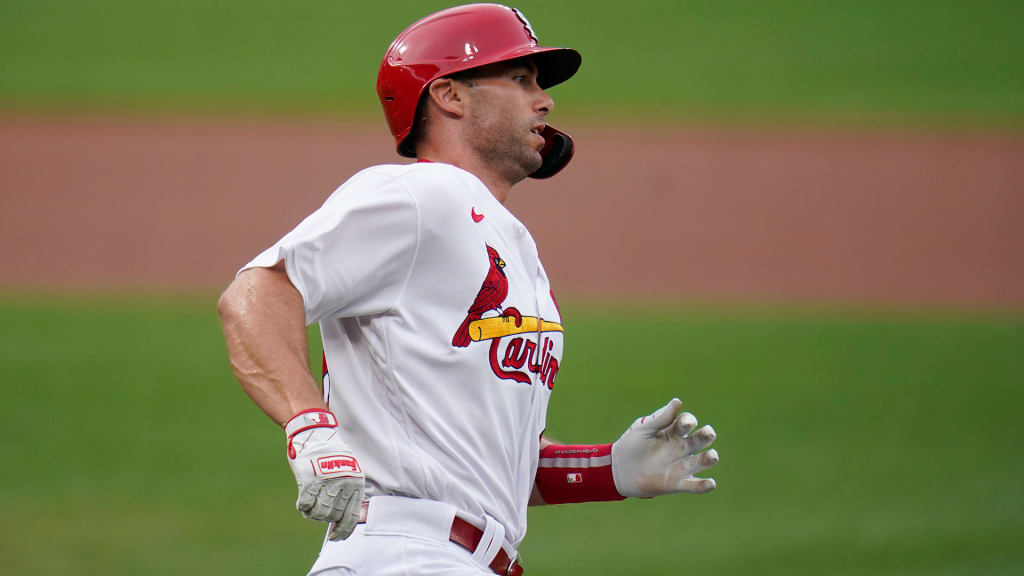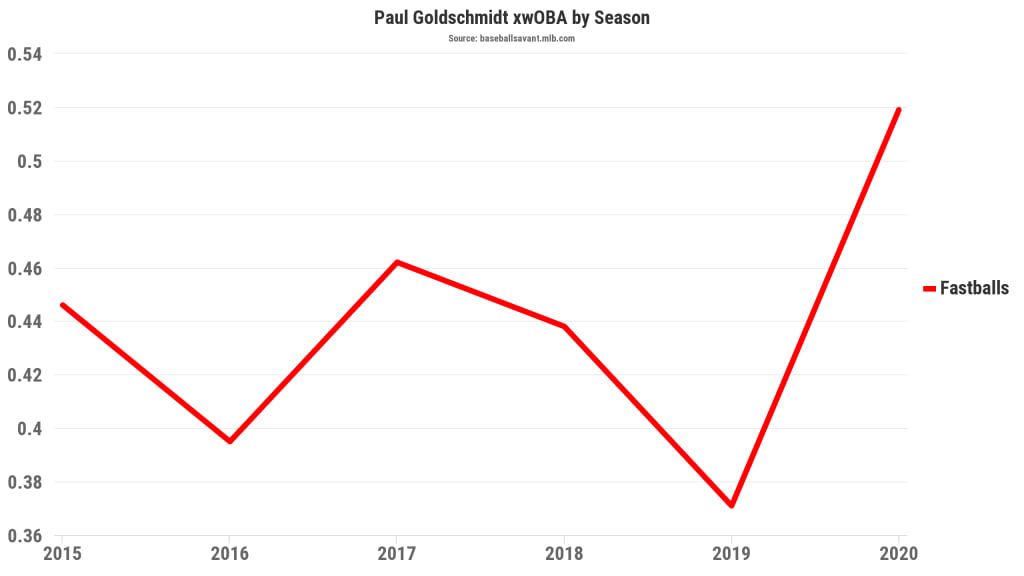
The Cardinals’ offense has been a below-average unit this season (4.27 runs/game, 96 OPS+), but the team’s struggles haven’t extended to the centerpiece of its lineup, first baseman Paul Goldschmidt.
Entering Thursday's action, Goldschmidt is slashing .310/.439/.497 with six homers over 180 plate appearances, and his resurgence at age 33 is surely a welcome sight for the Cardinals, who have the veteran slugger under contract for $104 million from 2021-24.
Acquired from the D-backs in December 2018 for catcher Carson Kelly, right-hander Luke Weaver, infielder Andy Young and a Competitive Balance Round B Draft pick, Goldschmidt posted solid counting stats (34 homers, 97 RBIs, 97 runs scored) during his first season with the Cards, but he also recorded a career-worst OPS+ (114) with his lowest average (.260), on-base percentage (.346) and slugging percentage (.476) since his 48-game rookie season in ’11.
In 2020, the first baseman’s performance has stacked up with some of his best seasons with Arizona, and his 155 OPS+ is his highest since 2015, when he had a career-high 168 mark.
Goldschmidt’s OPS+, last five seasons
2016 -- 133
2017 -- 142
2018 -- 142
2019 -- 114
2020 -- 155
Alongside Brad Miller, who has posted a 145 OPS+ after signing a one-year deal with St. Louis in February, Goldschmidt has helped keep the Cardinals in the postseason hunt.
Goldschmidt ranks 10th among qualified hitters with a .424 xwOBA, which takes into account quality of contact as well as real-world strikeout and walk numbers. Miller is 12th at .420, but no other Cards player is above .348. Goldschmidt’s xwOBA in 2019 was .363, still solid but obviously not nearly as impressive as this season’s mark.
With less than two weeks remaining in the regular season, St. Louis may need a big finish from Goldschmidt to secure a playoff spot. Here’s why the first baseman could be up to the task, and why the Cardinals should be comfortable building around Goldschmidt, even as he moves into his mid-30s. (All stats below are through Tuesday.)
Better plate discipline, fewer whiffs
Playing in his 10th big league season, Goldschmidt has recorded the best strikeout (14.4%) and walk (18.4%) rates of his career, and he ranks fourth among qualified hitters with a 1.28 BB/K ratio.
The first baseman has seen MLB’s second-largest drop in strikeout rate (9.9 percentage points) and is tied for the fourth-largest increase in walk rate (7.0 percentage points) from 2019 to ’20.
He’s made those improvements with better plate discipline, lowering his chase rate from 28.4% -- his highest since Statcast started tracking in 2015 -- to 21.3%, which has led to a lower whiff rate (misses/swings). Goldschmidt whiffed on 26.3% of his swings in 2019. This year, he’s at 22.6%.
As a result, Goldschmidt's rate of hard-hit balls (95+ mph exit velocity) per swing has jumped from 13.6% to 16.0%, even though his overall hard-hit rate is down a few ticks (42.4% to 39.7%).
He’s falling behind in the count less often
With his reduced chase and whiff rates, Goldschmidt has gotten ahead of pitchers much more often this season, and it’s started (unsurprisingly) with the first pitch.
In 2019, Goldschmidt fell behind, 0-1, 54.9% of the time, the fourth-highest mark in MLB (min. 500 first pitches seen). And after going down, 0-1, he hit just .238/.310/.404. This season, he has gone to 0-1 only 47.7% of the time.
Interestingly, while Goldschmidt’s swing rate on the first pitch has dropped to 20.1% (30.6% in 2019), his called-strike rate on the first pitch is virtually the same, which speaks to his improved plate discipline.
Overall, Goldschmidt has been behind in the count on 25.0% of the pitches he's seen this season, down from 30.5% in 2019.
Goldschmidt also has been a much tougher hitter with two strikes, posting a .404 xwOBA with an 11.7% putaway rate (strikeouts/two-strike pitches). In 2019, his xwOBA with two strikes was .292, and pitchers recorded a 17.1% putaway rate against him.
Again, improved plate discipline is at the root of his turnaround, as Goldschmidt has cut his chase rate on two-strike pitches out of the zone from 36.7% to 27.3%.
He’s crushing fastballs
Arguably the most encouraging takeaway from Goldschmidt’s resurgence is how well he has performed against fastballs this season, evidence that his bat isn’t slowing down despite his advancing age.
After recording a .240 average with a .553 slugging percentage and a .365 wOBA against fastballs (four-seamers, two-seamers/sinkers, cutters) last year, Goldschmidt has hit .364 with a .727 slugging percentage and a .483 wOBA in 2020, and his expected stats vs. fastballs rank among the best in the game.

Goldschmidt was especially poor against higher-velocity offerings in 2019, hitting .149 with a .299 slugging percentage vs. pitches that were 95+ mph, but he has posted a .280 average with a .440 slugging percentage against such pitches in '20.
All of Goldschmidt's 14 barrels -- batted balls with the optimal combination of exit velocity and launch angle, typically resulting in extra-base hits -- have come against fastballs this season, including three on 95+ mph pitches, and his 19.2% barrel rate on fastballs is the 11th-highest mark in MLB (min. 50 batted balls on fastballs).
With the Cubs sitting pretty atop the National League Central, the Cardinals are essentially battling five other teams for three NL postseason spots. If they don't grab one of them, it will be time to start thinking about rebuilding their offense heading into 2021.
At the very least, Goldschmidt has shown that he can still be the fulcrum of the St. Louis lineup. He just needs some help.
